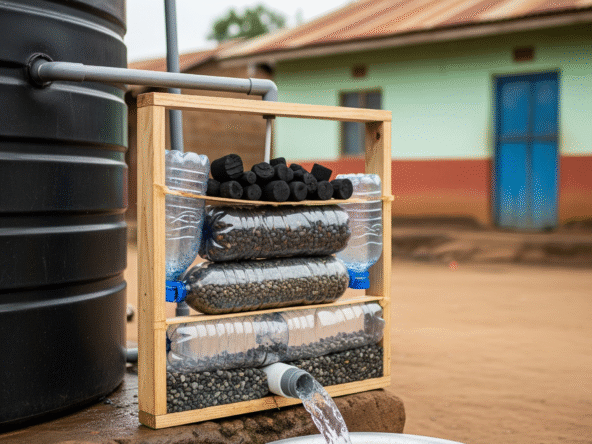For many Kenyan homeowners, farmers, and developers, a gravity-fed water system remains one of the most cost-effective and energy-free ways to deliver water throughout the home or farm. Whether you’re dealing with frequent water shortages, unreliable electricity, or simply want a low-maintenance setup, gravity-fed systems are ideal.
This guide explores tank options, height recommendations, plumbing essentials, and real-life applications in Kenya plus how to integrate them with other storage solutions.
1. What Is a Gravity-Fed Tank System?
A gravity-fed system stores water in an elevated tank on a stand, roof, or hill and uses gravity to push water downwards through plumbing to desired locations like taps, toilets, or irrigation zones.
Quick Pressure Guide:
Water pressure (in bars) = Tank height (m) × 0.1
A 3-meter-high tank = 0.3 bar pressure—enough for basic indoor use.
Learn how to construct your own stand in DIY Tank Stand Construction in Kenya
2. Best Tanks for Gravity Systems
| Tank Type | Capacity | Ideal Use |
|---|---|---|
| Plastic water tanks | 500L–10,000L | Homes, rentals |
| IBC tanks | ~1000L | Garden irrigation, small plots |
| Steel tanks | 5000L–50,000L | Institutions, farms |
| Underground tanks | With pump support | Backup only |
Not sure which brand to choose? Start with Top Water Tank Brands in Kenya
3. How High Should You Mount the Tank?
| Height (m) | Estimated Pressure | Suitable For |
|---|---|---|
| 1 meter | 0.1 bar | Handwashing, garden taps |
| 2–3 meters | 0.2–0.3 bar | Kitchen, bathroom taps |
| 4+ meters | 0.4 bar or more | Showers, hose irrigation |
For better performance, use reinforced metal stands or masonry pillars. Avoid wooden supports unless well-treated and off the ground.
4. Basic Gravity-Fed Plumbing Essentials
To get your system running smoothly, you’ll need:
- Ball valves for water control
- PVC or HDPE pipes (¾”–1” diameter for good flow)
- Sloped plumbing lines to aid gravity
- Elbows and T-joints for distribution
- Overflow pipe to redirect excess water safely
- Debris screen or filter at tank outlet
For water-saving outlet fixtures, refer to Water-Saving Plumbing Tips
5. Practical Use Cases in Kenya
Gravity-fed systems are common in:
- Rural homes far from municipal lines
- Rental units where tenants share a tank
- Kitchen gardens and greenhouses using drip or hose systems
- Construction sites with no power access
They also pair well with Rainwater Harvesting Systems for eco-friendly, pump-free water reuse.
6. Pros and Cons
✔ Advantages:
- No electricity or pump needed
- Low maintenance and simple parts
- Works even during power outages
- Easy to scale with additional tanks
✘ Limitations:
- Limited pressure for upstairs plumbing
- Cold water only
- Requires elevation space
- Flow may slow with long horizontal pipe runs
To counter pressure issues in showers or hilly homes, consider pairing with Affordable Solar Water Heating Solutions
7. Efficiency Tips for Long-Term Use
- Clean tanks every 3–6 months to prevent algae growth
- Use dark-colored or covered tanks to reduce light exposure
- Minimize unnecessary pipe bends
- Install first-flush diverters if capturing rainwater
- Ensure the base is stable and compacted to avoid leaning or collapse
For multi-tank households, check out Multi-Tank Linking Systems
A gravity-fed tank system is a smart, cost-effective water solution for nearly every type of home in Kenya—from rural bomas to Nairobi rentals. With the right tank height, fixtures, and plumbing layout, you can enjoy water access with zero energy bills and minimal upkeep.
Explore More Water Storage Ideas:


